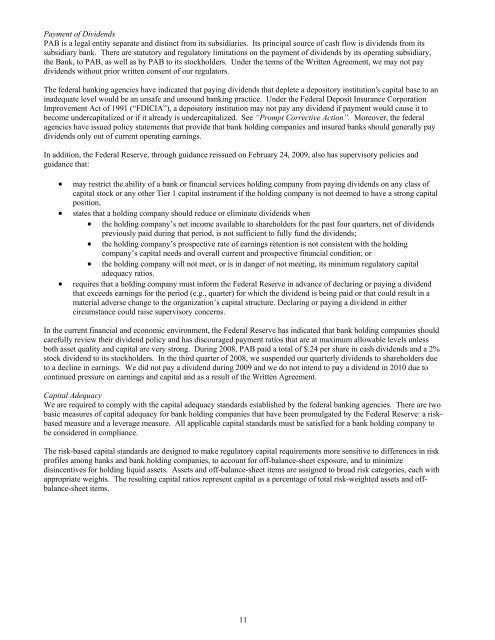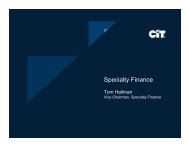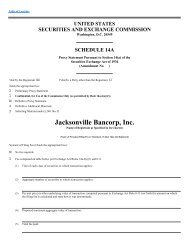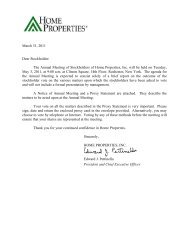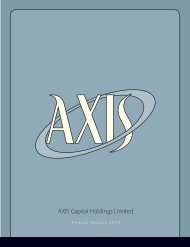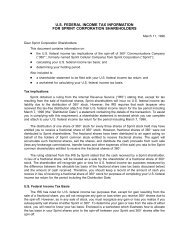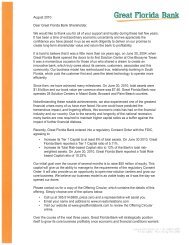pab bankshares, inc. - SNL Financial
pab bankshares, inc. - SNL Financial
pab bankshares, inc. - SNL Financial
Create successful ePaper yourself
Turn your PDF publications into a flip-book with our unique Google optimized e-Paper software.
Payment of Dividends<br />
PAB is a legal entity separate and dist<strong>inc</strong>t from its subsidiaries. Its pr<strong>inc</strong>ipal source of cash flow is dividends from its<br />
subsidiary bank. There are statutory and regulatory limitations on the payment of dividends by its operating subsidiary,<br />
the Bank, to PAB, as well as by PAB to its stockholders. Under the terms of the Written Agreement, we may not pay<br />
dividends without prior written consent of our regulators.<br />
The federal banking agencies have indicated that paying dividends that deplete a depository institution's capital base to an<br />
inadequate level would be an unsafe and unsound banking practice. Under the Federal Deposit Insurance Corporation<br />
Improvement Act of 1991 (“FDICIA”), a depository institution may not pay any dividend if payment would cause it to<br />
become undercapitalized or if it already is undercapitalized. See “Prompt Corrective Action”. Moreover, the federal<br />
agencies have issued policy statements that provide that bank holding companies and insured banks should generally pay<br />
dividends only out of current operating earnings.<br />
In addition, the Federal Reserve, through guidance reissued on February 24, 2009, also has supervisory policies and<br />
guidance that:<br />
• may restrict the ability of a bank or financial services holding company from paying dividends on any class of<br />
capital stock or any other Tier 1 capital instrument if the holding company is not deemed to have a strong capital<br />
position,<br />
• states that a holding company should reduce or eliminate dividends when<br />
• the holding company’s net <strong>inc</strong>ome available to shareholders for the past four quarters, net of dividends<br />
previously paid during that period, is not sufficient to fully fund the dividends;<br />
• the holding company’s prospective rate of earnings retention is not consistent with the holding<br />
company’s capital needs and overall current and prospective financial condition; or<br />
• the holding company will not meet, or is in danger of not meeting, its minimum regulatory capital<br />
adequacy ratios.<br />
• requires that a holding company must inform the Federal Reserve in advance of declaring or paying a dividend<br />
that exceeds earnings for the period (e.g., quarter) for which the dividend is being paid or that could result in a<br />
material adverse change to the organization’s capital structure. Declaring or paying a dividend in either<br />
circumstance could raise supervisory concerns.<br />
In the current financial and economic environment, the Federal Reserve has indicated that bank holding companies should<br />
carefully review their dividend policy and has discouraged payment ratios that are at maximum allowable levels unless<br />
both asset quality and capital are very strong. During 2008, PAB paid a total of $.24 per share in cash dividends and a 2%<br />
stock dividend to its stockholders. In the third quarter of 2008, we suspended our quarterly dividends to shareholders due<br />
to a decline in earnings. We did not pay a dividend during 2009 and we do not intend to pay a dividend in 2010 due to<br />
continued pressure on earnings and capital and as a result of the Written Agreement.<br />
Capital Adequacy<br />
We are required to comply with the capital adequacy standards established by the federal banking agencies. There are two<br />
basic measures of capital adequacy for bank holding companies that have been promulgated by the Federal Reserve: a riskbased<br />
measure and a leverage measure. All applicable capital standards must be satisfied for a bank holding company to<br />
be considered in compliance.<br />
The risk-based capital standards are designed to make regulatory capital requirements more sensitive to differences in risk<br />
profiles among banks and bank holding companies, to account for off-balance-sheet exposure, and to minimize<br />
dis<strong>inc</strong>entives for holding liquid assets. Assets and off-balance-sheet items are assigned to broad risk categories, each with<br />
appropriate weights. The resulting capital ratios represent capital as a percentage of total risk-weighted assets and offbalance-sheet<br />
items.<br />
11


